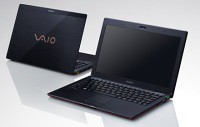Sony Vaio X

We use images here at ZDNet to help you get a feel for what we are talking about. There’s nothing revolutionary about that. But there are times when a picture just doesn’t cut it. Take this, for example

Just another Sony Vaio notebook, right?
Well, not really. It is the Sony Vaio X, and the picture can in no way give you an understanding of its dimensions in the hand. So instead you will have to imagine a notebook that measures 278mm x 185mm x 13.9mm and weighs 780g.
The carbon fibre and aluminium casing is fabulous to look at, the chicket keyboard really can be touch-typed on at normal speed – at least with my small hands I was able to achieve that, and the screen, an 11.1-inch LCD, delivers its 1366 x 768 pixels superbly.
I’m not one for hyperbole, but this has to be one of the most stunning portable computers I have ever seen.
There is support for mobile broadband in the shape of a SIM slot underneath the battery and the Vaio X comes with either 256GB or 128GB of SSD hard drive, and separate slots for Memory Stick and SD and compatible cards.
So far, it all seems very exciting. But if you covet the Vaio X you’ll need to know that prices start at £1,239. Which is a heck of a lot of cash, and you aren’t going to get a powerhouse of a computer for your money.
Depending on which model you choose the Vaio X runs an Intel Atom Z540 or Z550 processor making it more comparable with netbooks than notebooks, though Sony steers well clear of the word ‘netbook’ and puts in 2GB of RAM to help it move along more swiftly than other netbooks.
The sides have space for two USB ports, Ethernet, VGA-out and a headphones connector, but no more. There is a 0.3 megapixel webcam. The operating system is Windows 7 Professional. There is no optical drive.
The upshot is a fantastic looking computer that is light and has a super keyboard, but whose capabilities are on a par with top-end netbooks. Which makes it a very expensive choice indeed.
More information here.